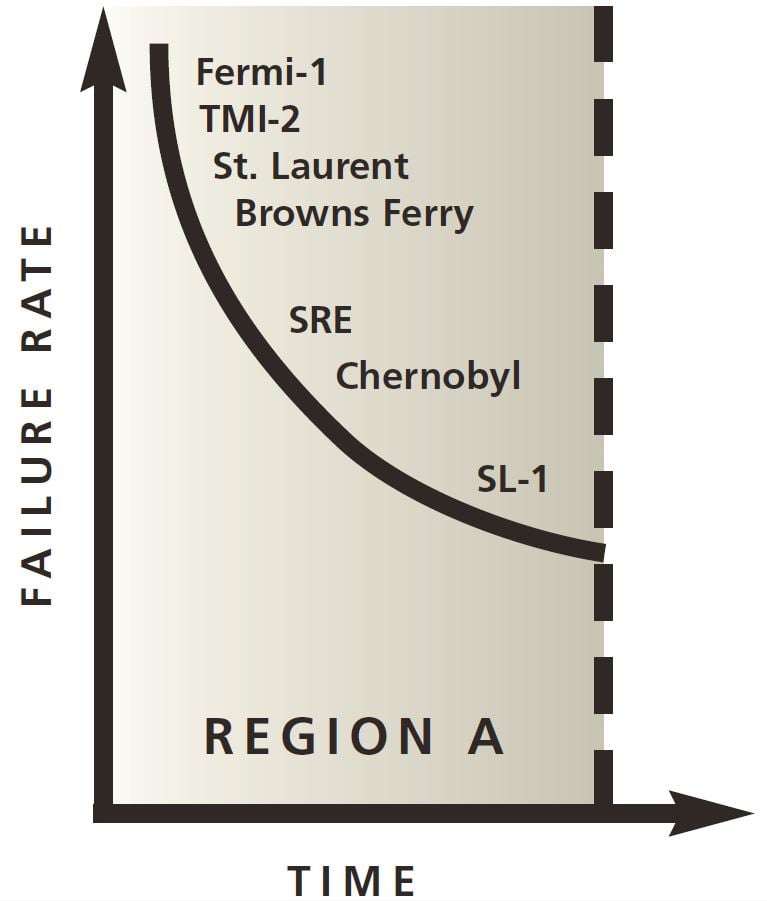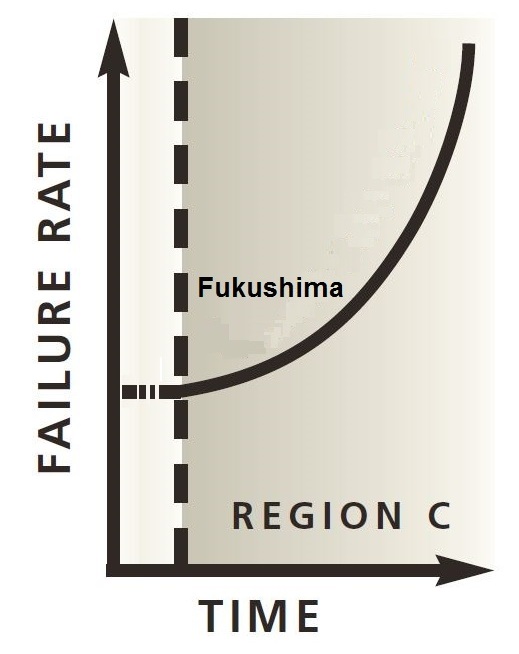Fission Stories #185
The Nuclear Regulatory Commission (NRC) originally licensed nuclear power reactors to operate for up to 40 years. Beginning in 2000, the NRC relicensed nuclear power reactors to operate for up to an additional 20 years. And there has been interest within the nuclear industry about for relicensing for yet another 20 years.
The chances of failure over expected lifetime is often represented by what is called the bathtub curve due to its shape (Fig. 1). The failure rate is initially high and decreases throughout Region A, the break-in phase. Failures due to material imperfections, improper assembly, and mal-operation cause this initially high failure rate. Rusting, embrittlement, and other aging degradation mechanisms cause the failure rate to rise later in life during Region C, the wear-out phase. Recent experiences at the San Onofre and FitzPatrick nuclear plants illustrate the bathtub curve in action.
San Onofre
The NRC licensed San Onofre Units 2 and 3 to operate in 1982. Over the next three decades, more and more tubes inside the steam generators had to be plugged (i.e., removed from service) by workers due to assorted indications of degradation. The plugged tubes included those damaged or weakened during fabrication, those broken after being struck by small particles in the high velocity water flowing through them, and those wearing out over time. Intending to avoid the increasing failure rates expected as the steam generators moved into the right-hand portion of the bathtub curve, San Onofre’s owner opted to replace the steam generators. Workers replaced the steam generators on Unit 2 in early 2010 and the steam generators on Unit 3 the following year.
In avoiding the increasing failure rate on the curve’s right-hand side, the owner invited the initially high failure rate on the left-hand side. And the invitation was accepted. On January 31, 2012, operators in the Unit 3 control room received clear indications that at least one tube inside the replacement steam generators had failed. The reactor was shut down to investigate the problem. At the time, the Unit 2 reactor was already shut down for a scheduled refueling outage. Workers discovered indications of excessive wear in hundreds of tubes in the steam generators on both reactors. The majority of the tube degradation was attributed to tubes vibrating against each other. The replacement steam generators had anti-vibration bars and retainers installed to restrict the movement of the tubes, but only in one direction. The manufacturer had not considered it possible for the tubes to vibrate side-to-side and had not designed any features to limit motion in this other direction. It took very little time for the tubes inside the replacement steam generators at San Onofre to rub themselves the wrong way.
The costs of either remedying this problem or operating at significantly reduced power to avoid it outweighed the benefit from continuing to operate the reactors. In June 2013, the owner announced that both reactors were permanently shut down. After spending nearly $700 million to replace the original steam generators to avoid the increasing failure rate in the wear-out region of the bathtub curve, San Onofre’s owner fell victim to the curve’s break-in zone.
FitzPatrick
The NRC licensed the James A. FitzPatrick nuclear plant to operate in 1974. Over the next three decades, more and more of the tubes inside the main condenser had to be plugged by workers due to assorted indications of degraded. Some condenser tube plugging is expected as plants navigate through the break-in and constant failure rate portions of the bathtub curve and perhaps even visit the wear-out region. But FitzPatrick overstayed its visit to the wear-out zone.
Between January 2003 and March 2013, UCS identified a total of 57 times when one of the nation’s 104 operating nuclear power reactors had to reduce power or shut down due to broken condenser tubes. FitzPatrick experienced 18, or 31%, of these events. The second highest number of events by any reactor over this span was only three. And FitzPatrick went on to pad its commanding lead—experiencing multiple power reductions each week as more worn-out tubes broke. Eventually, the owner even had to reduce the maximum power level of the reactor in an effort to slow the rate at which worn-out tubes broke.
FitzPatrick’s owner waited too long to replace worn-out condenser tubes and ventured deep into the wear-out zone where failure rates significantly increased. The condenser tubes were finally replaced during the plant’s fall 2014 refueling outage. It’s too soon to tell whether the replacement tubes will successfully avoid the initially high failure rates of the break-in zone.
More Dangerous Bath Tub
The San Onofre and FitzPatrick cases illustrate the economic consequences from the bathtub curve’s failure rates. But failures can have more dangerous implications.
The partial meltdowns of the reactor cores at Fermi Unit 1, Three Mile Island Unit 2 (TMI-2), and the Sodium Reactor Experiment (SRE) all occurred early in life during the break-in phase. The uncontrolled reactor power excursion accidents, and the fatalities they caused, at Chernobyl Unit 4 and the Stationary Lower Power Reactor 1 (SL-1) also happened during the break-in phase.
The disaster at Fukushima might be the first major nuclear plant accident to occur in the wear-out phase. The Unit 1 reactor at Fukushima Daiichi was about three weeks shy of its 40th anniversary and the Unit 2 and 3 reactors were just a little younger.
Earthquakes and the tsunamis they spawn are not aging degradation mechanisms that Fukushima and other nuclear plants can protect against as they enter the wear-out phase. But the age of a nuclear plant can be a factor in decisions about protections taken, or not taken, against external hazards like earthquakes and tsunamis.
For example, researchers identified in 2008 that an earthquake centered offshore from the islands of Japan could cause a tsunami wave to arrive at Fukushima Daiichi much taller than its protective seawall. Fukushima’s owner decided not to upgrade protective measures based on the very low likelihood of this earthquake/tsunami occurring during the remaining operating lifetime of the plant.
But what if this hazard had been discovered earlier, when the reactors were still in the break-in phase? In this case, any investment the owner made in upgraded protective features would have been insurance against this hazard for decades rather than only for a few years.
Our Takeaway
My thanks to Richard Solomon for being a frequent reader of my series of blog postings and for emailing the suggestion to comment about nuclear plant aging.
The bathtub curve illustrates that risk is a reality throughout the operating lifetime of a nuclear power plant. The risks are highest during the break-in and wear-out phases of the lifetimes.
In our 2004 report titled “U.S. Nuclear Power Plants in the 21st Century: The Risk of a Lifetime,” UCS described the risks over the lifetime of a nuclear plant and made recommendations for better managing these known risks.
During a February 2011 workshop on nuclear plant license renewal co-sponsored by the Department of Energy and the NRC, UCS described shortcomings in the NRC’s current license renewal process. Basically, the NRC was not revisiting past decisions not to implement safety upgrades to see whether such decisions would be different if the applicable reactors operated for 20, or 40, more years.
During a day-long public meeting conducted on subsequent license renewal by the NRC on May 9, 2012, UCS presented a number of concerns with the license renewal process. We pointed out that while the NRC twice revised its acceptance criteria for granting 20-year extensions to operating licenses, the NRC has not gone back and required owners of previously relicensed reactors to meet the new criteria. Thus, nuclear plant safety is bizarrely dictated by position in the license renewal queue rather than by science.
And although many owners have identified safety upgrades for their plants that would be cost-beneficial, the NRC has not required any of these safety improvements to be taken. The NRC has taken the curious position that the regulations only require owners to perform the safety upgrade evaluations, not to then take any steps—even those judged cost-beneficial—to better protect the American public from the inherently dangerous nuclear plants.
During a presentation to the NRC Chairman and Commissioners on May 8, 2014 about subsequent license renewal, UCS reiterated the “safety by queue position.” We also pointed out that the NRC’s license renewal process merely assumes, rather than verifies, that reactors are in compliance with applicable regulatory requirements. We pointed out that this assumption, while convenient and labor savings, has been proven invalid again and again.
It is well-established that failure rates increase during the wear-out phase of the bathtub curve.
It is equally well-established that the NRC’s license renewal process has shortcomings in properly managing these increasing risks.
If these shortcomings are not rectified, we will face the increasing likelihood of populating the wear-out portion of the curve with major reactor accidents just as Three Mile Island, Chernobyl, and others populated the break-in portion.
“Fission Stories” is a weekly feature by Dave Lochbaum. For more information on nuclear power safety, see the nuclear safety section of UCS’s website and our interactive map, the Nuclear Power Information Tracker.



